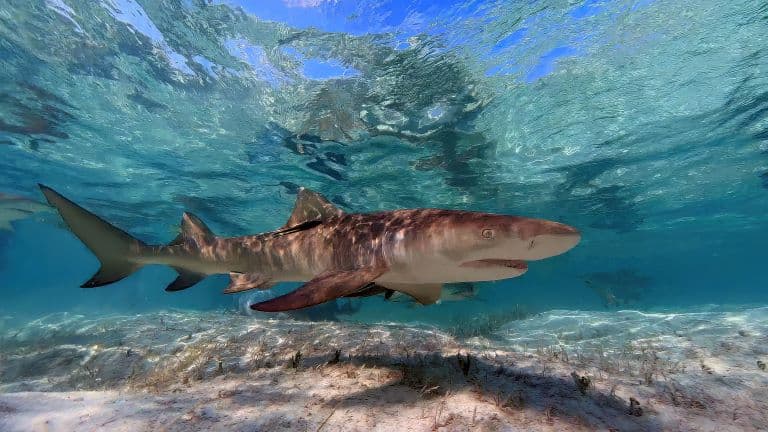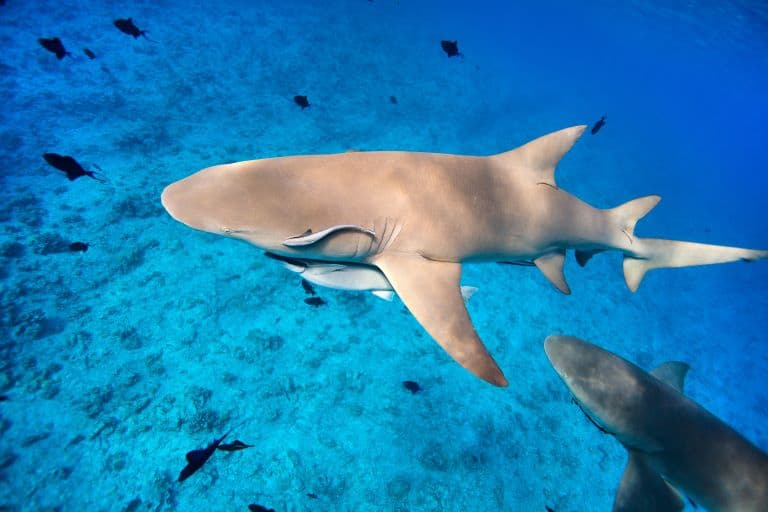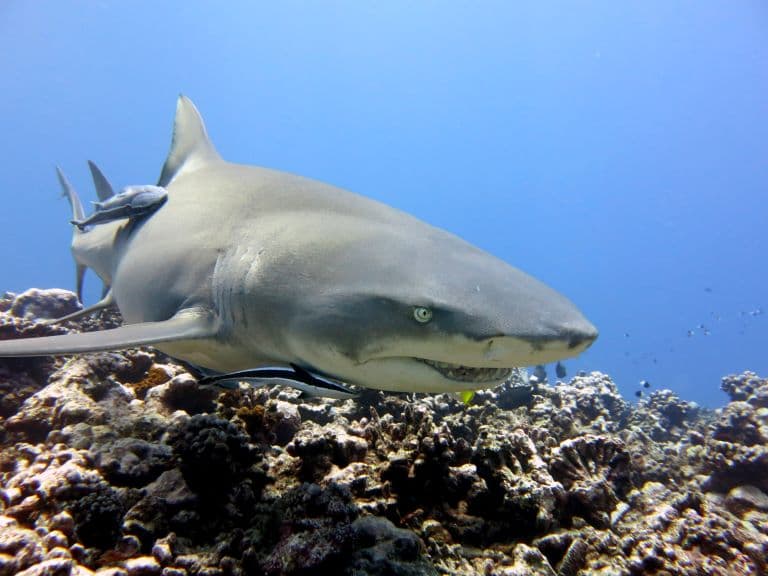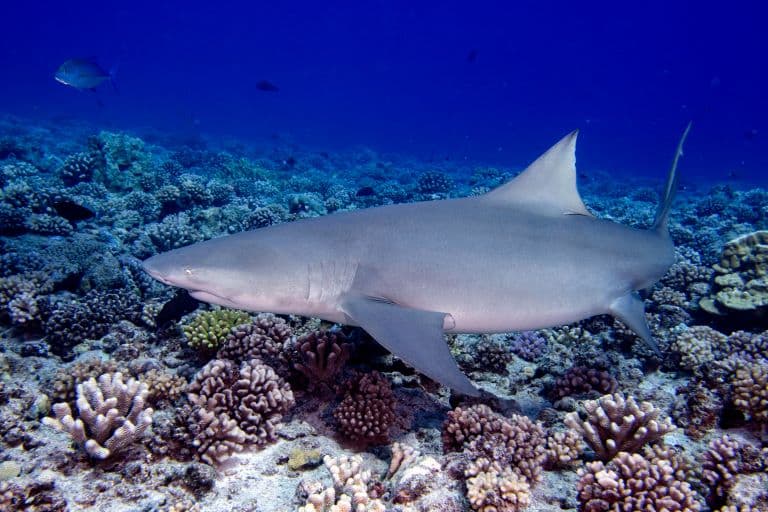Lemon Shark Profile
The bull sharks are certainly the brutes of the requiem order, but their genus gets all the attention. A lesser-known genus, Negaprion, contains a pair of sharks with a similar presence. Reef sharks, packing some serious muscle, and are so tough they have split the world’s warm, coastal waters between just two territories.
In the east, the sicklefin dominates. But from West Africa to New Jersey, the coast belongs to the lemon shark: an impressively muscular and mean-looking shark that hunts in the dark.

Lemon Shark Facts Overview
| Habitat: | Coastal marine, reefs |
| Location: | West Africa and the Americas |
| Lifespan: | At least 30 years |
| Size: | Up to 3.4 metres (11 ft) |
| Weight: | Max 183.7 kg (405 lb) |
| Colour: | Slightly yellowish grey |
| Diet: | Mostly fish, come crustaceans |
| Predators: | Larger sharks, humans |
| Top Speed: | Unknown |
| No. of Species: | 1 |
| Conservation Status: | Vulnerable (IUCN) |
Lemon sharks are incredible-looking, mid-to-large sharks that run the night shift around the warm, shallow coastlines of the Americas and West Africa. They are fish hunters and know what they like. These aren’t your everyday opportunistic feeders – they have a schedule and they keep to it.
Lemon sharks are one of only two very similar species in the genus, and they use highly attuned electroreception and good old-fashioned hearing to pick out their prey under the cover of darkness. These sharks might be smarter than average and are definitely more social, but there’s still quite a lot to learn about them.
Interesting Lemon Shark Facts
1. They’re half of the Negaprions
These large, slow-moving sharks make up half of the genus Negaprions, which contains the Indo-Pacific variety known as the sicklefin lemon shark, and this one, who roams the other side of the planet.
It appears they are both so tough they decided to stay out of each other’s way and divide up the land between them.
They’re bulky, for a requiem shark, but they don’t go quite as beastly as the bull sharks, and maintain a sort of athletic and muscular appearance. Their skin can have a coppery, or slightly yellow tinge to it, helping them stay camouflaged in the sandy shallows and giving them their name.

2. They’re predictable
It’s a common belief that sharks just roam around, grabbing whatever they can find to eat. This ties into the mindless predator trope that’s so common in the public’s perception of sharks.
But lemon sharks appear to have a deliberate routine in their lives. They’re organised between breeding and feeding and are relatively picky about what they eat.
Lemon sharks prefer fish, and they have a very clear preference for certain species and sizes. Being rather slow and big sharks, they don’t like to chase things much, so they go more for animals who use camouflage as a defence.
They also have a clear preference for breeding sites, showing a level of specificity not always assumed of sharks. Females gestate for around 12 months, and give birth to live young, who grow up sheltered in shallow mangrove environments.1
3. They’re nocturnal
All sharks can sense electricity to some degree, using special, gel-filled pores in their noses that react to small electrical impulses.
Lemon sharks are particularly adept at using this sense, as they hunt at night, so they have a well-honed set of electroreceptors which they use to pick out their prey in the dark.
4. They use sound too
But studies seem to suggest that this is a shark that’s quickly drawn to struggling prey and therefore has pretty good long-range hearing for the purpose.
Feeding frenzies occur in this species as a result of one individual making a successful hit and taking a chunk out of a fish.
The panicking victim is heard by others and soon they all dive in. This species feeds by snapping wildly and then shaking very violently to tear off a chunk of flesh.

5. They’re social
This species doesn’t just take advantage of one another, they also work together. Group hunting is common in lemon sharks, and they are also said to have friends and preferred associates within the group, especially as juveniles.
They’ve been shown to prefer both similar-sized sharks and sharks of the same species, much preferring to hang out with other lemon sharks than the, presumably, dumber nurse sharks they are often housed with. 2
6. They have big brains
This unusual social behaviour might be a product of their above-average intelligence.
Lemon sharks have very large brains in relation to their body size, more commonly found in mammals and birds, and in the latter two classes, this correlates with much more complex social behaviours.
This is still an area of shark behaviour that’s being teased apart by marine biologists but appears to be a very promising avenue of study in relation to the complexities of shark social dynamics. 3
7. They’re not dangerous
Lemon sharks are huge and mean-looking, but unless you’re a fish, they’re not generally interested.
Despite looking a lot like their meaty and aggressive cousins the bull sharks, this species doesn’t have the same inclination toward human ankles. 11 bites have been recorded from both species in this genus, and none were fatal.
This is a slow-moving shark that relies on stealth more than power and knows what it likes. 4

8. They do well in captivity
This tough shark is resilient and not so hard to look after, so research benefits tremendously from captive individuals housed in aquaria. This species is really abundant in the Bahamas, and a lot of what’s known comes from a single researcher, Dr. Samuel Gruber, who studied them there for decades.
More contemporary research is ongoing with captive sharks in Florida and San Diego aquariums, among others.
Lemon Shark Fact-File Summary
Scientific Classification
| Kingdom: | Animalia |
| Phylum: | Chordata |
| Class: | Chondricthyes |
| Order: | Carcharhiniforms |
| Family: | Carcharhinidae |
| Genus: | Negaprion |
| Species: | brevirostris |
Fact Sources & References
- Cortés, E. (1990), “Cortés, E., Gruber, S. H., & Cortes, E. (1990). Diet, Feeding Habits and Estimates of Daily Ration of Young Lemon Sharks, Negaprion brevirostris (Poey)”, Sci Hub.
- National Geographic UK(2021), “Lemon Sharks Hunting ”, YouTube.
- T.L. Guttridge (2009), “Social preferences of juvenile lemon sharks, Negaprion brevirostris”, Science Direct.
- Katie Carman, “The Lemon Shark Is a (Relatively) Friendly Shark”, howstuffworks.
